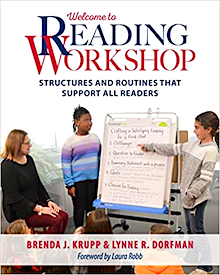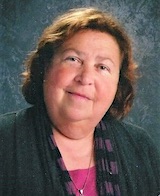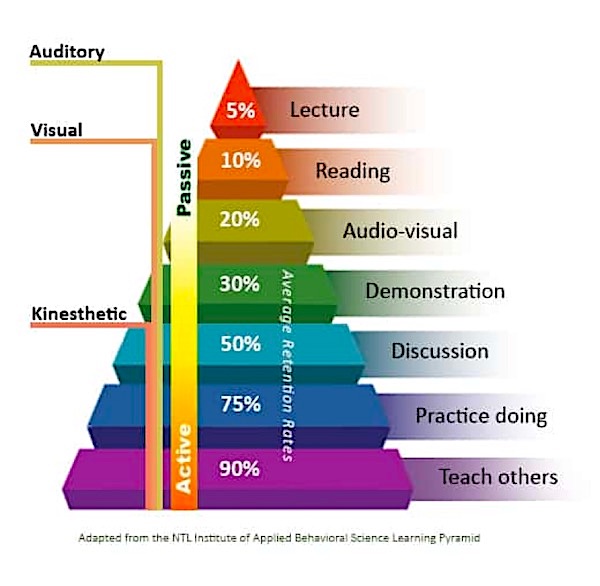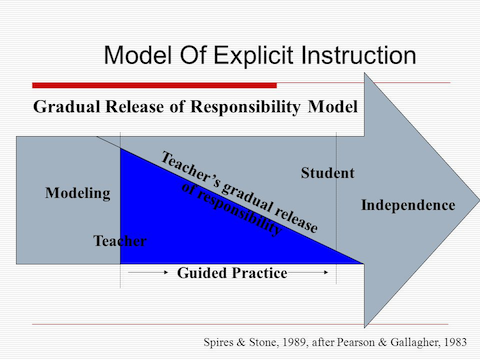What If We Taught Less and Facilitated More?
By Aileen Hower & Lynne R. Dorfman
If our immodest proposal to teach less and facilitate more strikes you as radical thinking that falls outside the lines of cutting edge pedagogical research, spend a few minutes thinking about this:
As the graphic below reflects, students remember only 5% of what is shared with them during a lecture, versus 50% through discussion, 75% through practice, and 90% through teaching others.
Conclusion: By focusing our efforts on facilitating learning rather than relying on traditional teaching methods, the retention by students will increase, and as a result, reteaching time will be significantly reduced.
What IS Facilitation?
In education, facilitation refers to the act of engaging students in creating, imagining, discovering, and applying learning. Facilitation skills are essential in present day classroom settings, and their effective use requires that teachers have done what is necessary to have trust and confidence in their audience.
Today’s secondary students are not looking for an information provider – they are looking for a mentor and guide. Today’s classrooms are not rooted in textbook-based resources. A teacher’s job is to help students connect their new learning with previous experiences. In other words, the teacher’s role is to facilitate learning.
Another way of thinking about the idea of facilitating learning versus teaching was succinctly explained by Kelly Gallagher (NCTE Conference, 2019) who stated that the person who’s doing the most talking in the classroom is doing the most learning.
Kelly’s message is clear: teachers need to shift who is doing the most work, listen more, and allow students to write, talk, discuss, revise their thinking, and learn more.
Getting Off the Center Stage
When we focus on traditional teaching methods, the instructor often takes center stage. Certainly, there is a place for direct instruction. But if most of our day is centered on talking “at” our students, they take less of an active role and become more dependent on us.
The Gradual Release of Responsibility Model is a key component of shifting to powerfully facilitate learning in our students.
This structure allows time for the teacher to complete explicit, direct teaching, but not for the entirety of the lesson. Rather, students are provided with opportunities to practice (guided and then independently) the concepts that the teacher has introduced to them.
GRR also allows the teacher to work one on one or in small groups to provide further guidance and instruction with students who are in need of more input from the teacher. Additionally, this model allows teachers to collect formative assessment data and see their students’ learning in action. This will powerfully guide future instructional decisions.
For a deeper dive into the
Gradual Release of Responsibility
see the MiddleWeb series
Letting Go Is Messy
Another way of viewing this is to consider the idea of a strategically planned mini-lesson at the start of any learning session. Whether in reading, writing, or a content area class, “mini” is just that – a short amount of explicit, systematic, direct instruction.
If a lecture is necessary, teachers can flip the content learning before the lesson through technology. Nearpod or EdPuzzle are two examples of technology we can use to provide students access to explanations and teacher-facilitated Q&A at home or prior to the lesson.
Readily accessible video mini-lessons allow students to front-load the content and be ready in class to complete tasks which could include rich discussions and opportunities to write, research, and share their new learning with others. The mini-lessons also serve as supports when students need to revisit the content.
Knowing What to Teach and How to Shift
Facilitating teaching does not mean we reduce our work – it’s about shifting our work to new purposes. It’s about knowing what to teach so that your students will be better prepared to take charge and navigate tasks on their own.
There are many ways that teachers can provide students with guidance while students are the ones steering the learning. Scaffolds with strategies such as those offered by Beers & Probst (Notice & Note, fiction & nonfiction) and resources such as sentence stems can help to jumpstart writing and conversations (When Kids Can’t Read: What Teachers Can Do, Beers, 2023).
Teachers can also structure routines to promote conversations in an orderly, meaningful way. Techniques such as fishbowls, “Save the Last Word for Me,” the Socratic Seminar Method, Quadrant Response, and Tea Party are all great tools to support student learning and give them ownership in the learning process, while diminishing the fear that students “taking the lead” will result in chaos.
Here are some things we can do to facilitate learning:
- Introduce key vocabulary and phrases to prepare your students for the task at hand. Introduce vocabulary self-selection and the practice of keeping a vocabulary notebook. Use graphic organizers such as Concept of Definition and the Frayer Model.
- Observe conversations without chiming in, if possible. Listen for points of confusion or concepts and understandings that need clarification but resist the urge to interrupt them while they are speaking. The teacher can always provide feedback in the final share and reflection.
- Establish time limits to provide some boundaries. A timekeeper can also be assigned for partner/group work (this role should be modeled!) to keep students focused on the task at hand.
- Teach students how to stay with a text (reading & rereading and managing their attention – where their focus is when they read something for class).
- Think alouds – use mental modeling to make your comprehension process visible to your students (Cris Tovani).
- Create text sets and easy access to texts that are well written and on several levels, but that are rigorous. Adapt text sets to different content areas to give students choice and provide them with accessible texts they can manage independently to absorb the information and concept to be learned and come up with more questions to ponder and research.
- Make sure to provide a choice in reading material so students feel validated and engaged with their text decisions.
- Reinforce thinking routines. Time for thinking and how to hold their thinking may be new to many students. They have been taught that the teacher is the question maker. When students find ways to hold their thinking while reading, they are more willing to return to the text to clarify their thinking and participate more in class discussions.
- Encourage annotation. Teaching students how to be an engaged reader by annotating the text, which can include an artistic response, is not a quick process but a valuable one. Cris Tovani (2004) urges students to respond to the text when annotating instead of just copying what the author has stated. Make sure that students know that readers often go back and reread parts of the text that were confusing or just didn’t make sense.
- Create opportunities to reflect both on the content and also on how students approached the content: what they knew before learning, what might have shifted or challenged their current thinking, how they incorporated or rejected the information based on other resources and evidence (Beers & Probst).
- Nurture students’ voices. Creating an environment that fosters sharing and feels safe and builds trust often means you take the time to develop discussion guidelines and a protocol while teaching/reviewing social skills (how to have a successful conversation or peer conference).
- Develop reader confidence and range by bringing a variety of texts into your classroom that students read in their daily lives. This action will build confidence and self-esteem. Try to understand how students approach these texts and gain understanding from them. Then ask students to read short pieces of text representing a wide range of unfamiliar genres and organizational formats.
- Go deep. Focus on depth, not breadth. By slowing down and digging deeper, students can reach greater understandings, have more time to develop good questions, and be able to see the big picture as well as the smaller details.
- Let them set their own purposes. Teaching students to determine their own purposes for reading will help them think about their reading processes. Soon students will learn that they must vary their reading process depending on their purpose for reading.
It’s All about Balance
It is important to find a balance between the roles of a teacher and a facilitator. As facilitators, teachers support each student’s journey to take the new learning and make it meaningful and sticky (we want the learning to stick with them!).
Facilitating learning makes the hard work of teaching more relevant and understood by our students. Best of all, teacher-as-facilitator provides the educational atmosphere and environment where students have myriad opportunities to fulfill their intellectual, social, and emotional growth.
We would never ask a musician to practice scales without then being able to play a whole song in front of an audience. The scales are akin to the information that students need. Of course, musicians need to practice scales, just like students need to learn their math facts and syllable types. However, if students don’t get to show what they know in applied situations, or hold discussions about this knowledge, they will never truly master the learning.
Scales are needed because they create the foundation to help in the joyful experience of bringing a piece of music to life and sharing that beauty with others; but someone learns how to become a musician. Musicians develop their own style, experimenting with different genres and sounds to find their own unique style. They keep growing, experimenting and continuously learning from others.
When we facilitate learning, students develop their unique voices and drive the instruction. They are an integral part of the learning process. And just like a conductor, the teacher gets to celebrate their successes as they show what they can do!
Aileen Hower is past president of the Keystone State Literacy Association and assistant professor and graduate coordinator of the Masters in Education in Language and Literacy at Millersville University, as well as the graduate coordinator of the Program Specialist in ESL Certification. Currently, she serves KSLA as the ILA coordinator.




































